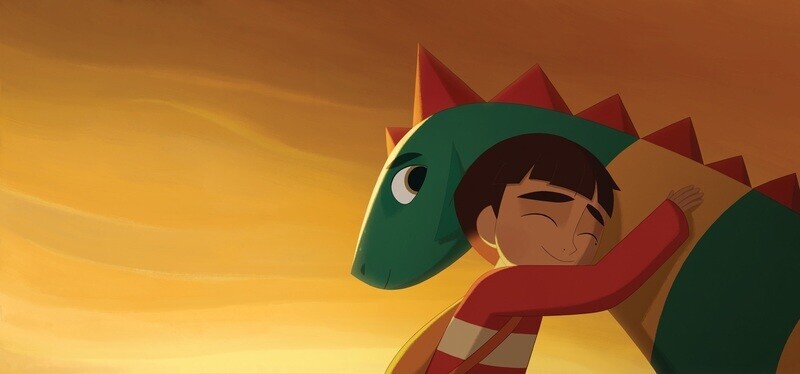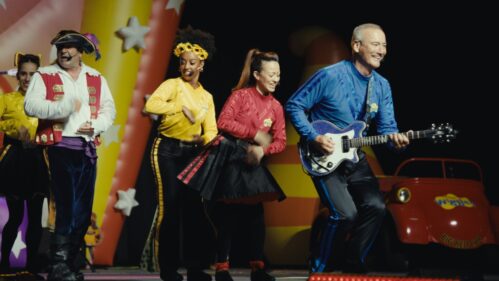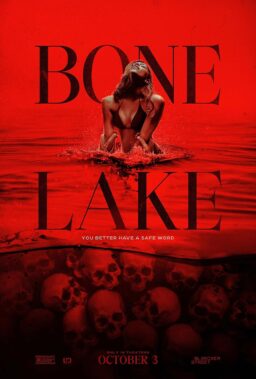Nora Twomey describes herself as a “hands-on” director of animated films. Her latest, “My Father’s Dragon,” follows her acclaimed films “The Secret of Kells” and “The Breadwinner,” all created through traditional hand-drawn animation. In an interview, she talked about why hand-drawn animation is so important to her and what moment early in the story made her decide to direct the film, which will be available November 11 on Netflix.
The book series by Ruth Stiles Gannett about Elmer and the dragon has been a favorite of families for generations. What was your first experience with the book?
I first read the book back in 2012 when I was contacted by Julie Lynne, who is one of our producers on the film. She had read the book as a child and had grown up to read the book to her children. And she and Meg LeFauve, a screenwriter on “My Father’s Dragon,” wanted to get in contact with us because they had seen “The Secret of Kells” and they had the rights to Ruth’s book, and they wanted to just meet up. And so on the way up to the meeting to meet Julie, I read the book and I think it was in a couple of pages, that page where Elmer gives a saucer of milk to the cat, and his mom gets really angry with him. I was just completely hooked. I thought, “Whoa, there’s such an amazingly layered story going on here.”
I knew that if I was a child reading that that I might not necessarily get it from the mom’s perspective. I would get it from Elmer’s perspective. But I couldn’t help but imagine what was going on in her life that a saucer of milk was a big deal, what was really going on at that moment. And then I thought of it from Elmer’s perspective, looking up into his mom’s face and probably seeing something that he didn’t recognize. And I just thought it was such a wonderful moment. I thought that if we could bring that sensibility through an entire film narrative that we could do something wonderful. And so, as somebody who had been a child whose parents oftentimes didn’t tell me the entire truth in order to protect me, I understood that moment. And I understood it as a mother who has also at times looked into my children’s faces and tried to manage what I had to say to them in order not to scare them. I understood that. I thought it was just such a profoundly powerful moment that from that moment on I just knew I was going to do what I needed to get this story onto the screen.
I like the way the film shows a parallel between what the mother does to try to protect her child and what Saiwa does to try to protect his community. Both are honest with the best of intentions.
Absolutely. And I think there’s also a parallel in how Elmer tries to control things in a way that stops the feeling of thinking, to stop the feelings of being unsafe, to try and protect his friends and people that he cares about or has come to care about on that island. For all of us who are confronted with some kind of conflict in our lives, to try and see it from the perspective of others is often a good way forward.
It can also be a kind of a coming-of-age moment, the moment where you realize that there are different perspectives, that maybe what’s important to you might not be important to somebody else, or how to see things from the perspective of another is something that happens especially around the age of Elmer who’s just heading into his teenage years.
I love that dynamic and I love the relationship that Elmer has with Boris the dragon because we worked really hard to not ever really let them know what’s around the corner. And sometimes they only have each other and they can only rely on each other as they try and navigate the world. With this film, we didn’t really want to have an ending where Elmer got everything he wanted, or we didn’t want to let it be that Elmer had special powers or anything like that. We really wanted to have a mortal child, a real child at the center of all of this. And if the film has strength, that that’s where it is.
It’s that relationship that helps Elmer understand why it was hard for Elmer’s mother to tell him the truth about what was going on. He becomes responsible for Boris and so he understands what it is to be responsible for somebody else.
Yes, and he’s compromised as well. At times in the film, he’s not particularly truthful and he does things maybe for good reasons but maybe not great things. So I just love the fact that in a family film we could get all of that nuance into the characters. And not just Elmer and Boris but the secondary characters as well. Like the character of Saiwa is someone who is not a one-dimensional bad guy or anything like that. He has real responsibilities. And he’s just trying as are we all. So I just love the idea that we could explore all of these kind of different types of personalities or different ways of dealing with the world of Wild Island and that we’ve got a chance to explore that for the film.

It always interested me that the story is about Elmer but it is told by a child who is not even near to being born at the time of the story. What is the advantage of that as a narrative matter? Why is it called “My Father’s Dragon” and not “My Adventures with a Dragon”?
This film is really inclusive. So we want the film to work for everyone, very young children to people who are much older and might have experienced a lot of things in their lives. There are a lot of layers to this story. The idea that we begin and end the film with this wonderful, mature voice of Mary Kay Place who voices Elmo’s daughter, there’s a sense that ultimately things are okay. That Elmer grew up to be a good dad. He raised a daughter who sounds like a lovely person. And there’s a sense of a warm hug about that.
So if you have very young children, they will know even in some of the more intense moments that ultimately Elmer went on and was fine. That’s something that allowed us actually to explore things in a more tense way. So, there are moments in the film where you’re really not sure what’s going to happen next or if the island is going to completely sink. But it actually allowed us to kind of deepen and lean into those moments just to use that narrative structure of Elmo’s daughter leading us in and out of the story.

What makes a good voice actor? You’ve got an amazing cast in this film.
We do have an amazing cast in this film, and they all really leaped with full imaginations into their parts. They all have a childlike imagination and a childlike sense of trust. So, even though they’re in a dark room with a microphone with not much else besides me to work with they just jump forward with both feet. The fact that they can trust that much and are willing to give that much of themselves to the microphone means that I as a director can walk away with recordings that I can give to animators. They spend an entire week animating four seconds of a performance. So, four seconds might not even be a full sentence but that’s what they spend a whole week really exploring the physicality of that performance with the characters. So, if the actor doesn’t believe their part 100 percent, be it a gorilla or a child or a whale or a crocodile, if they don’t believe that 100 percent then the animator can’t believe it. And if the animator can’t believe it either then your audience can’t believe it. So, I just love the magic between the voice performance, the hand-drawn animation where you literally you get 12 drawings per second of a character performance, and the audience participation believing that bunch of lines is a character. There’s something magic between all of those elements that I love exploring.
As you said, it’s an actor alone with a microphone in a dark room. Actors are used to playing off of each other. What did you tell them about who they were talking to?
I’m very hands-on as a director. And so, with Ian and with Chris O'Dowd and a lot of our actors, I went behind the glass with them so I’m in their space and I work with them so that they know the physicality of each of their scenes, so they know where the camera is, for example. So, they know if the camera is far away from them or more intimate moments they know how much energy they have to give. I’m really there for them.
Early on in my career, I realized that actors, they just want you to help them. They just want the director to help them to do the best, to put their best up on the screen. And so, that’s what I do.
We were lucky with Jacob and Gaten that we managed to get them in the room together for a lot of their performance. So, they did some of the recording apart but most of the recording that they did they were together in the room. And because I think Gaten was 17 at the time and Jacob was 13, they were kids, and they just played together. So, the first thing that they did when they met was they sat into the recording sessions was they both had headphones on, and with the headphones, they could hear their mouth noises of each other, and they just started messing. They just started playing together and laughing at each other. And it just was silly moments like that.
They really did embody Elmer and Boris, they just had that dynamic, the magic I felt as a director. If I just put my hand in between their lines of vision it would just be electrifying. And indeed it was. They believed in what they were doing and they just had a sense of play about them. I think everybody that was part of the voice cast had that sense of play. I think I was really lucky to have such an incredible cast.

Why is it so important to continue to do hand-drawn animation in a world of computers?
There’s a timelessness to hand-drawn animation that I think is really unique and really special. For example, if I take a picture of a subject and we look at that picture, it tells you a certain amount. If I do a drawing of that subject it tells you a little bit about the subject but it also tells you a little bit about me and my compassion or my ability to slow down and really observe. And when you get that at 24 frames per second that’s really amazing. You feel the sense of all of the hands that go into making something.
We had a crew of 300 and 150 of those were artists who either drew the effects of the water at just the right scale and with the right amount of weight and gravity and design. The background artists gave us those critical brushstrokes that you can feel on the frames. For me, it’s pure magic. Oftentimes you might have 20 animators animating the same character. They all have to communicate to each other. How does Elmer take his backpack off? What happens to his face when he’s thinking something that he’s not necessarily saying? How do we let our audience in there? How do we navigate those moments? There is a love for humanity, I think, in artists and animators. They’re incredible human beings because they’re able to distill human experience and add motion to it in ways that are just absolute magic. So, I love spending time with animators because they just have a specific way of looking at the world around them. We all love watching people draw. I certainly do. And so, I think it tells you something a little bit extra.
Sometimes the more you take away, the more an audience can invest. So, distilling characters down to a couple of lines and then moving those through time can oftentimes let your audience participate more in storytelling rather than if you went down the whole uncanny valley kind of really evolved 3D or anything like that. It gives you something extra.
One thing the film does very well is handling a lot of tonal shifts from very gritty and sad and realistic to fantasy and adventure and comedy. How do you maintain kind of a control of the tone and keep us all together as that happens?
There are so many elements controlling the tone, and I do love that. I know from my raising my own children that life is very much like that. Where something very serious happens and then pretty quickly something else can happen that doesn’t seem quite so serious at all. And we all navigate those kinds of tonal shifts every single day of our lives.
Through a 90-minute film we navigate them with the score by Jeff and Mychael Danna and with our shot choices throughout the film as much as we do with the physical performances. Our editors would work on those tonal shifts to make sure that they always felt right. I work quite a bit and edit myself just to make sure that we never shift too quickly. But I also have a mind to what our score will eventually bring and what our sound design will eventually bring as well with the film. And so, those are not intellectually managed moments. They’re very much managed with the gut and the heart.
With animated film, you do all your editing before you animate it because it’s impossible to be able to afford to make extra footage or anything like that. So, it does take a lot of imagination but ultimately it’s just down to time, and just imagining what it is that the Danna Brothers would eventually bring with the music. And they’re just so experienced and gifted with handling human emotion like literally lifting the island with their amazing orchestra and their beautiful sense of melody or leaving you alone for a little while and letting you sit in silence for a little while. What I’m most proud of with this entire film is just how each and every department working on the project they just all run together in one direction, which is really amazing. It can be really difficult sometimes to make sure that everybody understands the sensibility of what we’re going for and that we all kind of run in that one direction. But with this film, everybody absolutely did, which is amazing.












